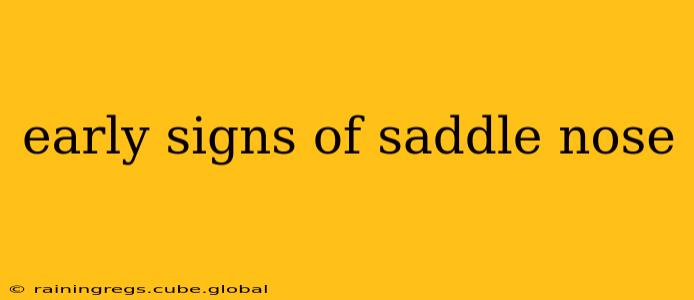A saddle nose is a nasal deformity characterized by a concave or caved-in bridge of the nose. While a fully developed saddle nose is easily recognizable, the early signs can be subtle and may go unnoticed. Understanding these early indicators is crucial for timely intervention and appropriate management. This comprehensive guide will delve into the early signs of a saddle nose, exploring potential causes and addressing frequently asked questions.
What are the First Noticeable Signs of a Saddle Nose?
The earliest signs of a saddle nose are often gradual and subtle. They might not immediately present as a "saddle" shape but rather as a change in the overall nasal profile. These initial signs can include:
- A slightly flattened nasal bridge: The bridge of the nose might appear less prominent than it once was, losing its normal, straight, or slightly convex shape. This flattening may be more noticeable in profile view.
- Increased nasal tip droop: The tip of the nose might begin to droop or point downward more than usual, creating an imbalance in the overall nasal symmetry.
- Changes in nasal breathing: Some individuals experience subtle changes in nasal airflow, possibly indicating underlying structural changes. This could manifest as mild stuffiness or difficulty breathing through the nose.
- Dorsal nasal skin changes: The skin over the nasal bridge might appear slightly thinner or tighter, potentially indicating underlying bone or cartilage changes.
What Causes a Saddle Nose Deformity?
Understanding the underlying cause of a saddle nose is essential for determining the appropriate treatment strategy. Several factors can contribute to the development of this deformity, including:
- Trauma: A broken nose or other facial injury is a common cause. Inadequate healing or improper reduction of a nasal fracture can lead to a depressed nasal bridge.
- Rhinoscleroma: This is a rare chronic granulomatous disease that primarily affects the nose and upper respiratory tract. It can cause progressive destruction of nasal cartilage and bone.
- Relapsing polychondritis: This rare autoimmune disease causes inflammation and destruction of cartilage throughout the body, including the nasal cartilage.
- Wegener's granulomatosis (Granulomatosis with polyangiitis): This is a rare autoimmune disease affecting blood vessels and causing inflammation in various organs, including the nose.
- Leprosy: This infectious disease can damage the nasal cartilage and cause a saddle nose deformity.
- Syphilis: In its later stages, syphilis can cause damage to the nasal cartilage.
- Previous Nasal Surgery: In rare cases, complications from prior rhinoplasty or other nasal surgeries can contribute to the development of a saddle nose deformity.
How is a Saddle Nose Diagnosed?
A thorough examination by a qualified medical professional, typically an ENT (Ear, Nose, and Throat) specialist or a plastic surgeon, is crucial for diagnosing a saddle nose. The diagnosis usually involves a detailed medical history, a physical examination of the nose, and possibly additional imaging studies such as X-rays or CT scans to assess the underlying bone and cartilage structures.
Can a Saddle Nose Be Prevented?
Prevention strategies focus on mitigating the risk factors:
- Prompt treatment of nasal fractures: Seeking immediate medical attention after a nose injury is vital to ensure proper healing and reduce the risk of developing a saddle nose.
- Early diagnosis and management of underlying diseases: Early detection and treatment of autoimmune diseases, infectious diseases, and other conditions that can cause nasal cartilage destruction are crucial.
What Treatments are Available for Saddle Nose Deformity?
Treatment options for a saddle nose vary depending on the severity of the deformity and the underlying cause. Common treatment approaches include:
- Rhinoplasty: Surgical reconstruction to reshape the nose and restore its normal contour. This is often the most effective treatment for a significant saddle nose deformity.
- Cartilage grafts: Using cartilage grafts from other parts of the body (e.g., ear cartilage, rib cartilage) to rebuild the nasal bridge.
- Medications: If an underlying medical condition contributes to the deformity, treating that condition might help to slow the progression or even improve the condition.
This information is for general knowledge and should not be considered medical advice. Always consult with a qualified healthcare professional for diagnosis and treatment of any medical condition. They can accurately assess your individual case and recommend the most appropriate course of action.
